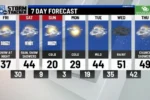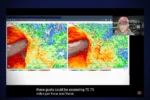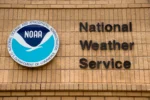Get ready for some exciting weather news, South Florida! This coming Monday, we might see heavy rain and even thunderstorms as a storm system moves through the area. The National Weather Service has warned that Palm Beach County could receive lots of rain, possibly more than four inches in some places! While this could help ease the drought conditions we’ve been experiencing, it also means we need to be careful of flooding in low-lying areas. So, grab your rain boots and umbrellas, and let’s learn more about what this storm means for our sunny state!
| Category | Details |
|---|---|
| Severe Weather Warning | Possible heavy rainfall and thunderstorms in South Florida on Monday. |
| Expected Rainfall | Palm Beach County may receive over 1 inch, with some areas up to 4 inches by Tuesday. |
| Flood Risk | Localized flooding possible in low-lying areas of coastal Palm Beach County. |
| Severe Weather Risk Level | Marginal risk of severe weather for southern Palm Beach County through the Keys. |
| Rainfall Statistics | Only 1.56 inches recorded since January 1, over 4 inches below normal. |
| Drought Status | Northern Palm Beach County in severe drought; southern part in moderate drought. |
| Storm System Details | Intensified by a strong air ripple; risk of thunderstorms but no tornadoes expected. |
| Weather Forecast | Dry conditions expected to return on Wednesday with another cold front later in the week. |
| Weekend Weather Outlook | Sunny weekend predicted with no rain and highs in the mid-70s. |
Understanding Severe Weather Warnings
Severe weather warnings are important alerts issued by meteorologists to keep people safe during dangerous weather events. In South Florida, the National Weather Service has warned residents about possible thunderstorms and heavy rainfall. These warnings help people prepare and take necessary precautions, like staying indoors during storms. Understanding these warnings can help families stay safe and avoid being caught off guard during severe weather.
When severe weather is expected, the National Weather Service uses a scale to indicate the level of risk. In this case, Palm Beach County has a marginal risk of severe weather. This means there is a small chance of storms that could produce heavy rain and strong winds. It’s important for everyone to pay attention to weather updates, especially when rain is expected, so they can stay informed about what to do if the weather worsens.
The Importance of Rainfall in Florida
Rainfall is essential for maintaining healthy ecosystems and water supplies. In South Florida, rainfall helps keep plants green and provides water for lakes and rivers. Unfortunately, this year has seen much less rain than usual, causing drought conditions in parts of Palm Beach County. Local farmers and residents rely on regular rainfall to grow crops and maintain gardens, so the arrival of rain can be a relief after a long dry spell.
The recent weather forecast predicts heavy rainfall in Palm Beach County, with some areas receiving up to four inches by Tuesday. This could help ease drought conditions and replenish water sources. However, too much rain can lead to localized flooding, especially in low-lying areas. It’s important for residents to stay aware of weather conditions and know where to find safe places if flooding occurs.
What to Do During Severe Weather
When severe weather is expected, it’s crucial to have a safety plan in place. Families should know the safest places in their homes to go during a storm, like a basement or an interior room away from windows. Having an emergency kit with supplies like water, food, and flashlights is also a good idea. Staying informed by listening to weather updates can help families react quickly if conditions worsen.
During heavy rainfall and thunderstorms, it’s best to stay indoors and avoid driving unless absolutely necessary. Flooding can occur quickly, making roads dangerous. People should pay attention to local emergency services for updates and follow their instructions. After the storm passes, it’s important to check for safety before going outside, as fallen branches or debris can pose risks.
Understanding the Impact of Heavy Rainfall in South Florida
Heavy rainfall in South Florida, particularly in Palm Beach County, can have significant effects on the local environment and infrastructure. With projections indicating up to four inches of rain in isolated areas, residents must prepare for possible localized flooding. This amount of precipitation can overwhelm drainage systems, especially in low-lying areas. Flood-prone zones may experience road closures, property damage, and disruptions in daily life, making it essential for communities to stay informed and heed weather warnings.
Additionally, heavy rainfall can lead to soil erosion and affect water quality in nearby lakes and rivers. As runoff increases, pollutants can wash into waterways, potentially harming local ecosystems. It is vital for residents to be aware of these environmental impacts and take preventive measures, such as avoiding unnecessary travel during storms and participating in community drainage improvement initiatives. Understanding the implications of heavy rainfall will help residents respond effectively and protect their homes and neighborhoods.
Preparing for Thunderstorms: Safety Tips for Residents
When thunderstorms are forecasted in South Florida, preparation is key to ensuring safety for you and your family. Start by securing outdoor items that could become hazardous if lifted by high winds. It’s also wise to stay indoors during severe weather events, keeping away from windows and avoiding electrical appliances that could pose risks during lightning storms. Having an emergency kit ready, including flashlights, batteries, and non-perishable food, can help you stay safe and self-sufficient during power outages.
Moreover, keeping a close eye on local weather updates is crucial. The National Weather Service provides timely alerts that can inform you about worsening conditions. Consider downloading weather apps that send notifications directly to your phone. Educating yourself on the signs of severe weather, such as darkening skies and sudden wind shifts, can also help you react quickly. By remaining vigilant and prepared, residents can navigate thunderstorms with a greater sense of security.
The Role of Drought Conditions in Severe Weather Forecasts
Drought conditions can complicate severe weather patterns, particularly in regions like South Florida. With Palm Beach County experiencing moderate to severe drought, the ground may struggle to absorb heavy rainfall effectively, leading to increased runoff and flooding. Understanding this connection between drought and rainfall helps residents anticipate potential challenges during storm events. For instance, even though rainfall is needed, the sudden influx of water can cause substantial runoff in areas that have been dry for an extended period.
Furthermore, drought conditions can exacerbate the effects of thunderstorms, such as lightning strikes and wind damage. Vegetation weakened by lack of moisture is more susceptible to being uprooted or destroyed during storms. Residents should be informed about the cumulative effects of drought and rainfall on their local landscapes and infrastructure. This knowledge not only increases awareness but also encourages proactive measures to mitigate risks associated with severe weather.
Looking Ahead: Future Weather Patterns in South Florida
As South Florida braces for a storm system, it’s essential to consider future weather patterns and their potential impacts. Although dry conditions are expected to return shortly after the rain, the forecast also indicates a cold front approaching later in the week. While it’s too early to determine the front’s exact effects, being aware of such patterns can help residents plan their activities accordingly. Staying informed through reliable weather sources allows individuals to be proactive rather than reactive.
Moreover, understanding seasonal shifts in weather can bring awareness to residents regarding long-term implications, such as drought cycles and storm frequency. Embracing this knowledge can empower communities to engage in discussions about climate resilience and preparedness strategies. By being proactive in weather awareness, residents can better navigate the challenges posed by severe weather and support one another in fostering a more resilient community.
Frequently Asked Questions
What is severe weather and how can it affect us?
**Severe weather** includes dangerous events like heavy rain or thunderstorms. It can affect us by causing **flooding**, damaging homes, and making it hard to travel.
Why is South Florida expecting heavy rain this week?
South Florida is expecting heavy rain because of an **area of low pressure** moving through. This weather system can bring **thunderstorms** and heavy rainfall, helping to end a drought.
What does the National Weather Service do?
The **National Weather Service** (NWS) predicts weather and warns us about severe conditions. They help keep people safe by informing them about things like **storms** and **flooding**.
What is a drought and why is it a problem?
A **drought** is when there is not enough rain for a long time. It can be a problem because it affects **plants**, **animals**, and our **water supply**, making it hard to grow food.
What can happen if there is too much rain quickly?
If there is too much rain quickly, it can cause **flooding**. This happens when water covers land that is usually dry, which can damage homes and roads.
What should we do during a thunderstorm?
During a **thunderstorm**, it’s best to stay indoors, away from windows. If you are outside, find a safe shelter. Avoid using electronics to stay safe from lightning.
What will the weather be like after the rain?
After the rain, the weather is expected to be **dry and sunny**. This means no rain and warm temperatures, perfect for outdoor activities!
Summary
The content discusses severe weather threats in South Florida, including heavy rainfall and thunderstorms forecasted for Monday due to a low-pressure system. Palm Beach County may receive over an inch of rain, with some areas potentially experiencing up to four inches, increasing the risk of localized flooding. The National Weather Service indicates a marginal risk of severe weather, although the system is expected to be disorganized. This comes amid severe drought conditions across the region, with rainfall significantly below normal for the year. Following this weather system, dry conditions are anticipated to return mid-week.







